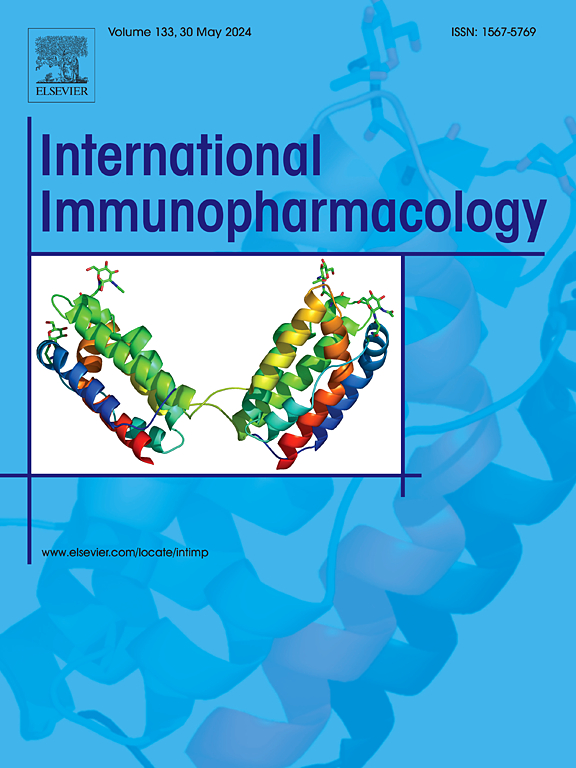自身免疫性脑炎伴CASPR2抗体:病例系列和最新文献综述
IF 4.7
2区 医学
Q2 IMMUNOLOGY
引用次数: 0
摘要
目的接触蛋白相关蛋白样2 (CASPR2)脑炎是一种未被充分认识且相对罕见的自身免疫性脑炎(AE)类型。在此,我们研究了CASPR2脑炎患者的临床表现和预后。方法回顾性收集CASPR2脑炎患者资料,分析其临床特点。此外,对以往报道的CASPR2脑炎的临床特点和预后进行了总结和分析。结果15例患者(中位年龄52岁;年龄范围:10 ~ 81岁,其中男性9例。研究的主要临床表现包括边缘系统症状(73.3%)、癫痫发作(53.3%)、精神-行为异常(20%)、周围神经亢奋(PNH)症状(20%)、四肢感觉异常(20%)、束状震颤(13.3%)、共济失调(13.3%)、意识受损(13.3%)、Morvan综合征(13.3%)、小脑症状(13.3%)和高肿瘤标志物(26.7%)。脑磁共振成像(MRI)和脑电图(EEG)异常信号值分别为33.3%和40%。13例(86.7%)患者接受了一线免疫治疗,12例(75%)患者在最后一次随访(18个月)时完全恢复(mRS = 0),但2例(13.3%)患者出现复发。此外,我们调查了文献中440例CASPR2脑炎患者的临床资料,包括25篇相关出版物,涉及315名男性。此外,37例患者在发病或复发期间出现肿瘤。随访时,212例患者mRS评分≤2分,50例患者mRS评分在3 ~ 6分之间。总共有43例患者出院时疾病复发,直到最后一次随访,免疫治疗改善了他们的症状。然而,14例患者在随访期间死亡。我们结合前人的相关研究对纳入的病例进行了总结,相关结果与前人的研究结果一致。结论CASPR2脑炎患者临床特征多样,表现为边缘系统症状、PNH症状、Morvan综合征、小脑症状等多种症状。在本研究中,大多数患者对免疫治疗反应良好,并且在短期内表现出较低的复发机会。从CASPR2脑炎的临床特点和预后角度对CASPR2脑炎的相关文献进行回顾,进一步加深了我们对该疾病的认识。因此,应持续监测CASPR2脑炎患者的复发及伴发肿瘤。本文章由计算机程序翻译,如有差异,请以英文原文为准。
Autoimmune encephalitis with CASPR2 antibody: A case series and updated literature review
Objective
Contactin-associated protein-like 2 (CASPR2) encephalitis is an under-recognized and relatively rare type of autoimmune encephalitis (AE). Here, we investigated the clinical manifestations and outcomes in patients with CASPR2 encephalitis.
Methods
The data of patients with CASPR2 encephalitis were collected retrospectively, and their clinical features were analyzed. Additionally, clinical features and prognoses of CASPR2 encephalitis in previously reported studies were summarized and analyzed.
Results
Fifteen patients (median age: 52 years; age range: 10–81 years, nine were male) were studied. The main clinical manifestations studied included limbic system symptoms (73.3 %), seizures (53.3 %), mental–behavioral anomalies (20 %), peripheral nerve hyperexcitability (PNH) symptoms (20 %), paresthesia of limbs (20 %), fasciculation (13.3 %), ataxia (13.3 %), impaired consciousness (13.3 %), Morvan syndrome (13.3 %), cerebellar symptoms (13.3 %), as well as high tumor markers (26.7 %). The values of abnormal signals in brain magnetic resonance imaging (MRI) and abnormal electroencephalogram (EEG) were 33.3 % and 40 %, respectively. Thirteen (86.7 %) patients received first-line immunotherapy, 12 (75 %) showed complete recovery at the last follow-up (18 months) on the modified ranking scale (mRS = 0), but two (13.3 %) patients experienced relapses. In addition, we investigated the clinical data of 440 patients with CASPR2 encephalitis available in the literature and included 25 relevant publications, which involved 315 men. Furthermore, 37 patients developed tumors during the disease or recurrence. At the follow-up, 212 patients displayed a mRS score of ≤2, and the mRS scores of 50 patients ranged from 3 to 6. In total, 43 patients displayed disease relapse during discharge until the last follow-up, and immunotherapy improved their symptoms. Nevertheless, 14 patients died during the follow-up. We have summarized here the included cases in the light of relevant previous studies, and the associated results conformed to those from previous studies.
Conclusions
Patients with CASPR2 encephalitis exhibited diverse clinical features and presented several symptoms, including limbic system symptoms, PNH symptoms, Morvan syndrome, and cerebellar symptoms. Most of the patients in the present study responded well to immunotherapy and exhibited a lower chance of recurrence in the short term. The review of the relevant literature on CASPR2 encephalitis from the viewpoint of clinical characteristics and prognoses of CASPR2 encephalitis further deepened our understanding of the disease. Thus, recurrence and concomitant tumors in patients with CASPR2 encephalitis should be continuously monitored.
求助全文
通过发布文献求助,成功后即可免费获取论文全文。
去求助
来源期刊
CiteScore
8.40
自引率
3.60%
发文量
935
审稿时长
53 days
期刊介绍:
International Immunopharmacology is the primary vehicle for the publication of original research papers pertinent to the overlapping areas of immunology, pharmacology, cytokine biology, immunotherapy, immunopathology and immunotoxicology. Review articles that encompass these subjects are also welcome.
The subject material appropriate for submission includes:
• Clinical studies employing immunotherapy of any type including the use of: bacterial and chemical agents; thymic hormones, interferon, lymphokines, etc., in transplantation and diseases such as cancer, immunodeficiency, chronic infection and allergic, inflammatory or autoimmune disorders.
• Studies on the mechanisms of action of these agents for specific parameters of immune competence as well as the overall clinical state.
• Pre-clinical animal studies and in vitro studies on mechanisms of action with immunopotentiators, immunomodulators, immunoadjuvants and other pharmacological agents active on cells participating in immune or allergic responses.
• Pharmacological compounds, microbial products and toxicological agents that affect the lymphoid system, and their mechanisms of action.
• Agents that activate genes or modify transcription and translation within the immune response.
• Substances activated, generated, or released through immunologic or related pathways that are pharmacologically active.
• Production, function and regulation of cytokines and their receptors.
• Classical pharmacological studies on the effects of chemokines and bioactive factors released during immunological reactions.

 求助内容:
求助内容: 应助结果提醒方式:
应助结果提醒方式:


